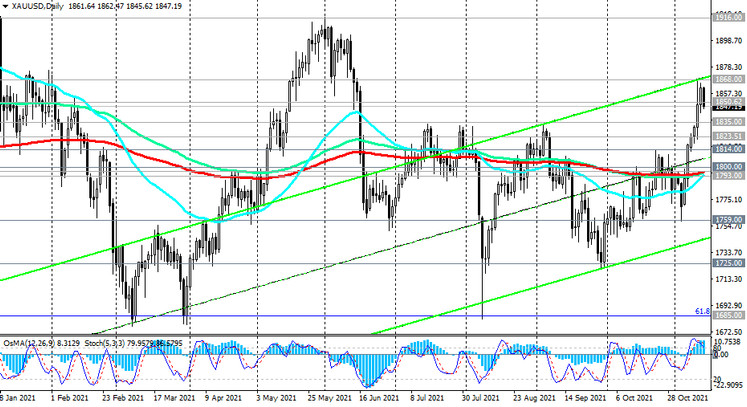As a result of the week of November 8-14, the dollar strengthened sharply. At the time of this posting, the DXY dollar index, which reflects the dollar's value against a basket of 6 major currencies, is close to 95.20 mark, which corresponds to mid-July 2020 levels, 90 pips above the week's opening price. The main reason for the strengthening of the dollar is the increased likelihood of an earlier than planned increase in the Fed's interest rate.
As follows from data published last Wednesday by the US Department of Labor Statistics, the US consumer price index (CPI) in October jumped by 6.2% (in annual terms), which was the strongest growth in the last more than 30 years (the forecast assumed an increase CPI +5.8% after rising +5.4% in September). The core CPI, which excludes volatile food and energy prices, rose +0.6% (+4.6% yoy), the largest increase since 1991.
Following the results of the meeting that ended in early November, the Fed leaders approved a plan to wind down the asset purchase program (this process will begin in November and should end by June next year). The Fed will cut bond purchases by 15 billion in November and another 15 billion in December. In the opinion of its management, such a reduction in the volume of acquired assets "is likely to be appropriate every month".
At the same time, the FRS interest rates remained at the same level, close to zero (the target range of the federal funds rate remained the same, 0.00% -0.25%).
At a press conference, Fed Chairman Jerome Powell reiterated that the central bank will not rush to raise interest rates, since the labor market has not yet fully recovered, and he still considers increased inflation to be a temporary phenomenon.
However, inflation in the US, peaking in more than 30 years, has heightened investor fears about price pressures in the global economy. Higher-than-expected inflation data raise the likelihood of an earlier tightening of the Fed's policy.
Meanwhile, according to data from the US Department of Labor, also published on Wednesday, the number of initial applications for unemployment benefits fell to 267 thousand compared with 271 thousand a week earlier, which is in line with pre-crisis levels. After the strong monthly data from the American labor market published on November 5, according to which in October the growth in the number of jobs outside of agriculture in the United States amounted to +531 thousand, and unemployment fell to 4.6% from 4.8% in September (in addition, in US non-farm jobs rose 312,000 in September, up from 194,000 previously reported), upbeat weekly jobless claims statistics also point to continued recovery in the US labor market. If the US labor market finally reaches pre-pandemic levels, and inflation is still not a "temporary phenomenon", then the Fed will have no choice but to start raising interest rates to reduce inflationary pressures.
Last year, the Fed formulated the conditions under which an increase in interest rates would be justified: inflation should aim at a moderate excess of 2%, and the labor market should return to the state it was in before the pandemic began. Now we see that inflation is well above the Fed's target of 2%, and perhaps this is not temporary, as the Fed believes. The most "modest" estimate suggests that the Fed will start raising interest rates in the summer of 2022, since the process of curtailing the asset purchase program that has begun should end, according to Fed officials, by June next year. Earlier Powell has repeatedly stated that the Fed will complete its quantitative easing program before raising the interest rate.
Thus, the Fed will become one of the first largest world central banks (after the central banks of South Korea, Norway, Brazil, Turkey and New Zealand) to take such a step. However, given the relative "weight" of the dollar and its share in international financial transactions, the Fed's actions in relation to its monetary policy are of paramount importance for the dynamics of the entire global financial market.
At the same time, along with the strengthening of the dollar, the price of gold rose sharply, despite the fact that the price of this precious metal is quoted in US dollars.
Gold quotes are extremely sensitive to changes in the monetary policy of the world's largest central banks, primarily the Fed. However, it seems that the conditional "scale pan" has tilted towards the risks associated with the accelerating growth of inflation. In the current situation, a natural conclusion suggests itself that if the Fed continues to refrain from raising the interest rate while inflation continues to grow, then one should expect an increase in gold prices (although gold does not bring investment income, this precious metal is used by investors as a defensive asset, in including from inflationary risks).
Today there is a decline in the DXY index and the XAU / USD pair, although these are contra directional trends. It seems that investors are taking profits at the end of the week by closing part of their long positions in the dollar and XAU / USD.
However, in our opinion, if the Fed continues to be inactive on the issue of tightening monetary policy (raising the interest rate), still assuring market participants that inflation is "temporary", and inflation will remain at the achieved levels or continue to grow, then we should wait further growth in gold quotes and the XAU / USD pair.

At the time of this posting, XAU / USD is traded near 1850.00 mark, dropping towards near-term support. The downward correction could deepen towards the important short-term support level 1835.00 (see Technical Analysis and Trading Recommendations), and this will still mean the continued bullish dynamics of XAU / USD. The breakdown of the local resistance level 1868.00 (highs reached this week) will create preconditions for further growth of the pair. In any case, being above the key support levels 1800.00, 1797.00, 1793.00, XAU / USD will remain in the bull market zone.





